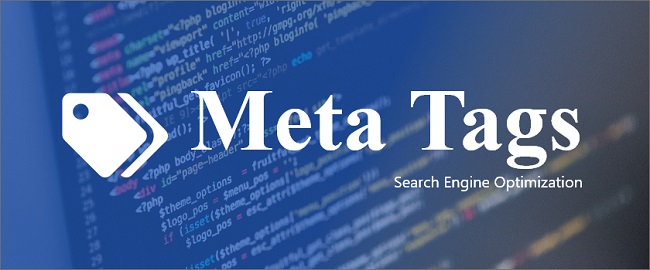When it comes to adding information about the web pages in the HTML for a document, the meta tags come into play. The information is usually known as metadata which serves the proper information to the web crawlers and search engines.
Search engines like Google, from the meta tags get the help to understand all the necessary information for the web pages. This information helps in ranking the SERPs.
This is why you must learn all the nooks and corners about the SEO meta tags while ranking your website. Here is a complete guide on how to start with it.
What are meta tags?
As you already know what meta tags are, it is time to know the proper definition of them. Meta tags are those elements in your website which offer information about your webpage and the HTML for the document.
This information is known as metadata. Even though it is not displayed on the page, it can easily be read by search engines and by web crawlers.
Search engines like Google make use of metadata from the meta tags, which helps understand all the additional information about the web pages.
They can easily use this information to hold a secure rank in SERPs. Meta tags usually use the title and description elements that serve proper information.
How do you start with meta tags?
Meta tags are the most important parts of SEO which plays a very crucial role in page ranking. Though the bad side of meta tags is quite popular on SEOs, it has some great aspects.
Meta tags are sometimes beyond just description and keywords, though these two elements are most popular here. But looking at both the good and the bad sides of meta tags can help you better to understand everything.
Though all the meta tags may not help you, still some of them have a great impact on your site. To boost your SEO performance, your meta tags must be accompanied by high-quality content that is highly focused on user experience.
The best thing you can do about it is, try to stick to the core minimum. It is better not to add meta tags that you do not need. Unnecessary meta tags will eat up your code space. It is always a better practice to keep the code less.
Know about good meta tags:
Good meta tags should be on each of the pages. While you are working on a small page, you can notice better what is required. Hence you can work with the following.
Meta content type: the meta content-type works as a highly necessary tag. It helps to declare all your character set for the pages that must be there on every page. Leaving this can affect how your page is offering it in your browsers.

Meta description: The meta description tag is highly used for some of the major purposes. It helps to describe the page to your searchers when they read it from the SERPs. At the same time, this tag does not influence the ranking.
However, it is highly important for your page. It works as the ad copy that helps to determine if the users are clicking on your result or not.
It is better to keep the meta description within 160 characters. Make sure you are writing it to catch the attention of your users.
Title: The title tag does not start with the meta. It works as the header that includes important information about SEOs. It is very important to keep your title tags unique on every page that describes the page properly.
Viewport: To optimize your website for mobile devices, you must specify your viewport. Use a standard tag for it to make sure that it is working properly. The standard tag is:
What are the different meta tags?
For various sites, it is important to use these specific kinds of tags. But it is better to avoid such tags at your best. Here is what you need to know about these tags.
Social meta tags: Social meta tags are one of such kind of indifferent meta tags that you might not want to use. The Twitter data and the Open Graph tags are important to share, but they are not always required.
Specific bots: These kinds of gas are used to offer specific bot instructions like noodp and noydir. The search engines are usually good at doing this kind of thing on their own. However, if you think you require it, feel free to use it.
Robots: there is one huge myth that you must have a robot meta tag. However, in terms of indexing and following the links, if you are not specifying the meta robot tags, they read as indexes, follow.
As you want to charge one of these two commands that you need to add to your meta robots, this scenario comes true. Moreover, if you want to noindex but follow the links on your page, it is better to add the tags with only the noindex.
meta name="robots" content="noindex" />
Geo: These meta tags get supported with Bing but not by Google. It includes three elements like position, place name, and region.
Language: You can use this tag if you are moving internationally, and you need to declare the main language that you have used on your page.
These meta tags are supported by Bing but not Google (you can target to country inside Search Console). There are three kinds: placename, position (latitude and longitude), and region.
Refresh: the refresh tag is a redirect and must not be used if there is no necessity. You must use a server-side 301 redirect.
Site verification: who will have the verification tags with the homepage? These are sometimes very necessary as you cannot get the other forms for site verification.
But it is better to verify your site in another way. Google lets you verify your site with DNS, external file, or linking through a Google Analytics account. Bing allows the XML file or the meta tags.
Keywords: This one is also indifferent. If you are building a site, then it is better to leave it. But if your site is automated, then there is no need to remove it.
What are the bad meta tags?
Well, using these meta tags will not do anything bad on your site. But they are simply a waste of space. Here are the bad meta tags that you need to know about.
Revisit after: These meta tags command the robots to return to a page after a specific time being. The major search engines do not follow it.
Author/web author: This tag is mainly in use for the name of the author on the page. It is not at all necessary.
Rating: This tag is mainly used to offer the maturity rating to content.
Generator: this tag is used to note what program has been used to create the pages.
Resource Type: The resource type is used for naming the type of the resource the page is using. Well, it is not at all that much important.
Cache-control: the cache control tag helps in controlling when the page gets cached in the browser. It works as the best way to do it with the HTTP header.
Distribution: The distribution value is used for controlling who can access the document. It is typically set as global. If you are working with a global site, then you can easily work with it, or you can simply leave this tag off-page.
Abstract: This tag is used to place an abstract for the content, which is mainly necessary for the educational pursuit.
Expiration/ date: The expiration is used for noting when the page expires, and the date denotes the date when the page was made. But is that even necessary to add to your page? Think about it!
Conclusion:
The meta tags are simply plenty in number. It is highly important to know the use of it before you add it to your web pages. Whether it is the good one or the bad one, you must use it while you feel that it is relevant to the context of your SEO.
Hence knowing all about the meta tags will serve you the best kind of results while you think of implementing it to your SEO.





